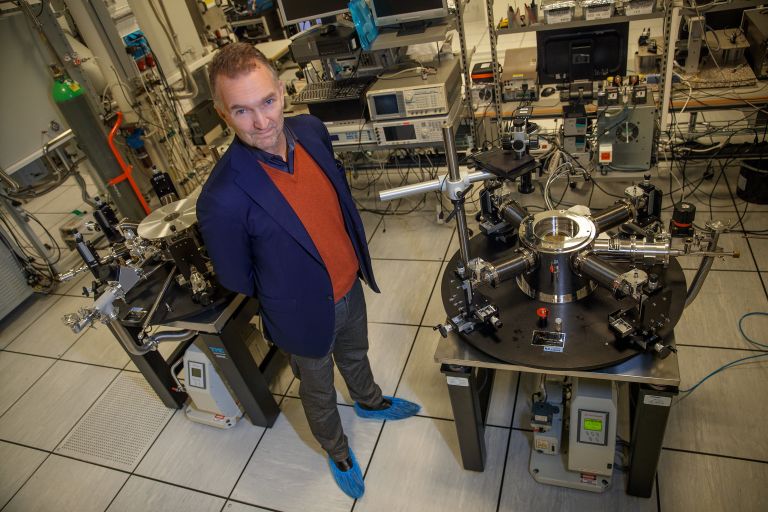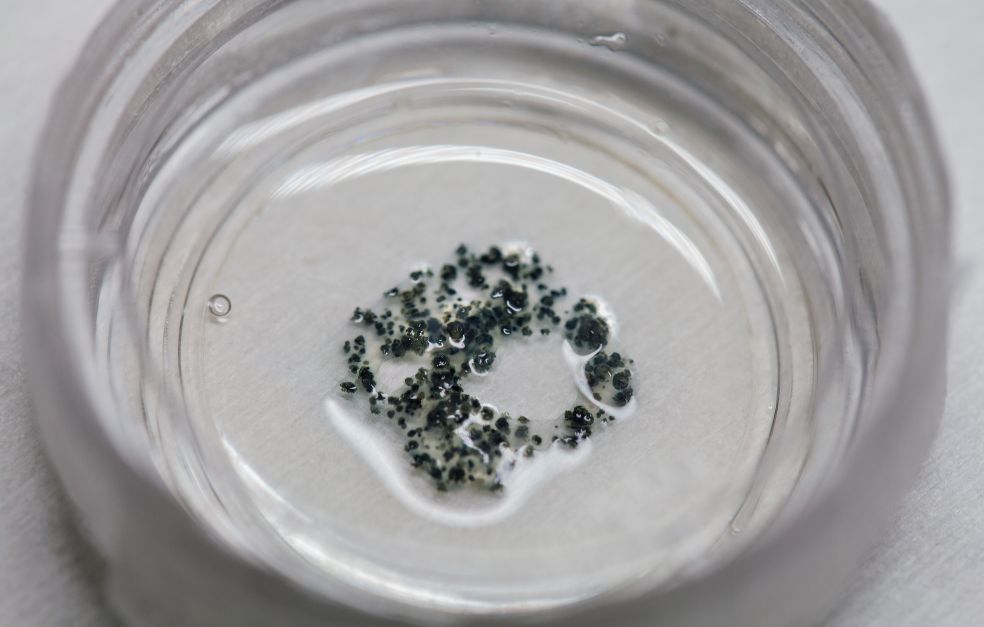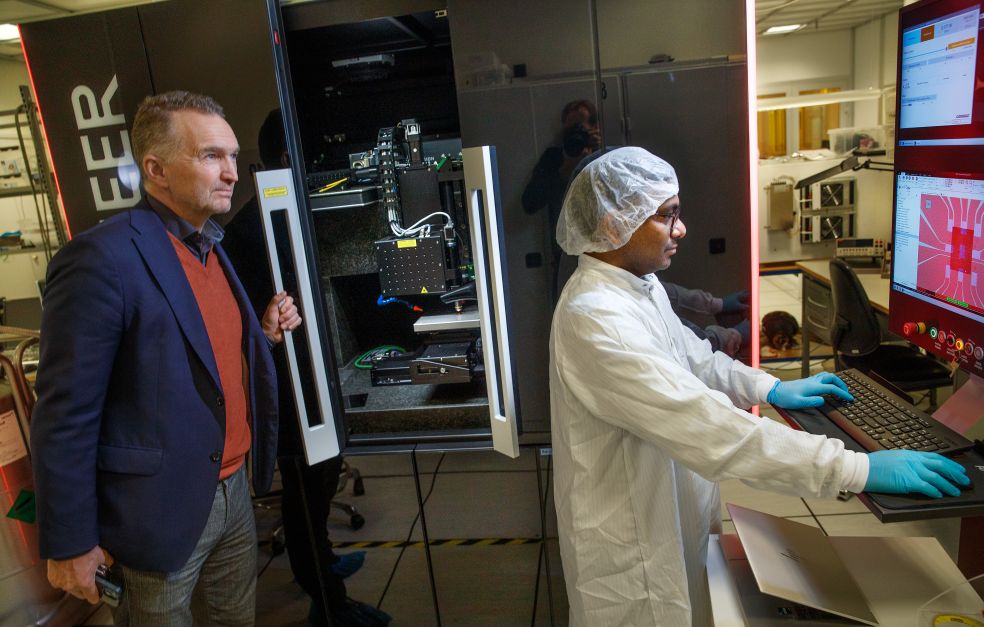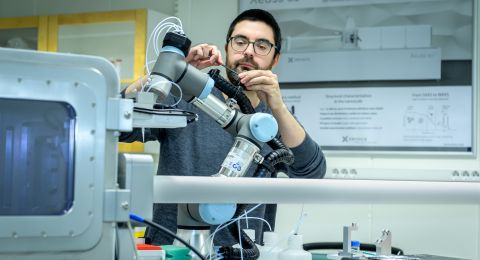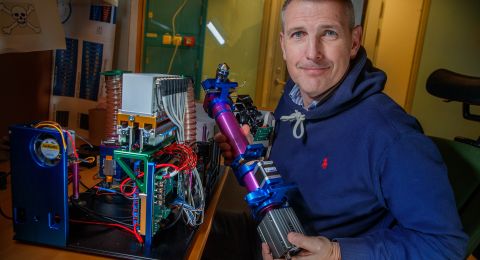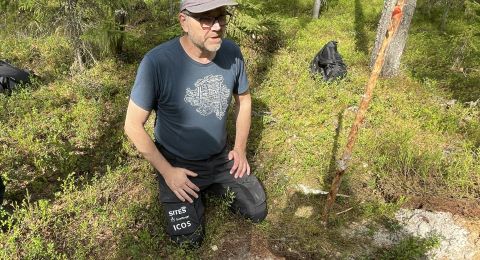The advances made in Magnus Berggren’s research lab have led to paper electronics as well as electronic circuits in plants. Now he is moving on to the human body to replace damaged neurons with conductive plastics.
Magnus Berggren
Professor of Organic Electronics
Wallenberg Scholar
Institution:
Linköping University
Research field:
Organic electronics for new applications in medicine, plant biology, electronic paper and energy conversion
Berggren’s research team created electronic circuits in plants as long ago as 2015. They “watered” roses with conductive polymers, impregnating the vascular system in the stems and leaves with electronic systems. The breakthrough opened up an entirely new research field. The researchers went on to develop the technology to use plants for energy storage and to control their growth rate electronically.
These advances are based on the discovery that a particular molecule spontaneously polymerizes in the plant to form an electrical conductor. But no one understood why it happened.
“It was a mystery. Then we realized that a combination of different enzymes and hydrogen peroxide were among the underlying factors. The idea of using the same polymer in nervous tissue to create new nerve fibers soon took shape,” says Berggren.
Road block
The first experiments were conducted on a millimeter-sized freshwater polyp called Hydra vulgaris. The method worked well there. But when the researchers repeated the same experiments in mammals, they came up against a sudden road block.
“Nothing worked, and it threw us into a year of pure crisis management.”
The setback forced them to revisit the very first decisions in their research to question every step. Only when they had learned how to utilize the environment and components of the nervous system did they find a solution.
“Once we had we cracked that code, we succeeded in our experiments with both leeches and zebra fish. One key solution was to use naturally available sugar as an energy source.”
Injectable heart stimulator
Working with researchers from Lund University and Karolinska Institutet, Berggren and his colleagues have developed the technology for use in a kind of injectable heart stimulator. The method enables small amounts of chemicals to be injected, forming a conductive electrode around the heart muscle. The electrode is then used to give the heart the electric shock it needs to beat regularly again.
“We have now managed to polymerize molecules both around the heart and in brain tissue. Most importantly, the immune system accepts our material. Even the encapsulated cells continue to live.”
Electrodes polymerized and formed inside the body have several advantages over current electrodes, which are rigid and normally require complex surgeries. If the electrode can instead be administered by syringe, entirely new, simpler and faster treatment methods can be used.
The next step is to grow and attach electrodes to individual cells in the body to create fine-mesh networks between the cells. Eventually, Berggren hopes to build both transistors and diodes, and even entire circuits, inside tissue.
Five years ago, I would have said that what we are doing was impossible. But thanks to our young stars in the lab, we have made unexpected discoveries that have made it a reality.
“We have also cracked the code for how to build electrical conductors around the cell membrane without interfering with the signals that control cell development and function. Now we want to see if we can create an electronic system that grows on its own between cells.”
One driver is to make a difference for patients with neurodegenerative diseases. It might be possible to replace damaged or destroyed neurons with organic electronics that restore lost abilities.
Other potential offered by the technology includes electronic circuits in the brain, enabling more advanced prosthetics to be controlled with the power of thought.
“We’ve always been fascinated by the interface between biology and electronics. We’re convinced we can do something completely new in the field,” says Berggren.
Sustainable materials
Alongside his research, Berggren is the director of WISE, Wallenberg Initiative Materials Science for Sustainability. The initiative aligns with the research goal of contributing to new materials for a sustainable society.
“It’s absolutely vital to develop new and more sustainable materials. Humanity extracts approximately 100 billion metric tons of materials annually, and much of it is not recycled.”
About 75 percent of human carbon dioxide emissions originate from material extraction, production and various material processes, he emphasizes.
“WISE is now in its third year. We have funded about 230 projects ranging from basic and applied research to new infrastructures for materials development.”
He stresses the importance of aiding the development of other researchers in his role as director as well as research leader. He describes his research colleagues as superstars.
“You’re never stronger than the organization you have helped to develop. If I have an idea I believe in, I share it immediately. If you do this with a group of ten people, you get nine other ideas in return. This helps you grow as a group.”
His research team operates in an open-plan office – PhD students and professors side by side. He believes this fosters collaboration and counters the traditional hierarchy in the research world.
“The proximity it creates is unbeatable. Together, we make mental journeys that would be impossible alone. Sometimes I have to pinch myself to understand how far we’ve come,” Berggren enthuses.
Text Magnus Trogen Pahlén
Translation Maxwell Arding
Photo Magnus Bergström

